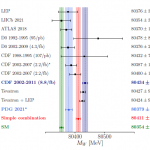Have we found new physics by measuring the W boson mass?

April 13, 2022 by RebecaBV
The Standard Model (SM) of particle physics is one of the most successful scientific theories up to date, being able not only to explain but also to predict a plethora of experimentally tested results. Be that as it may, there are still
many experimental facts, such as the existence of Dark Matter or neutrino masses among others, which cannot be explained within this framework and suggest the existence of physics beyond the SM.
Very recently, a new tension between the SM prediction and data arose: the CDF collaboration announced an updated, more precise measurement of the W boson mass.
" Have we found new physics by measuring the W boson mass?" document attached report by Giacomo Landini ( UVEG ESR) and Salvador Rosauro Alcaraz ( CNRS ESR).


